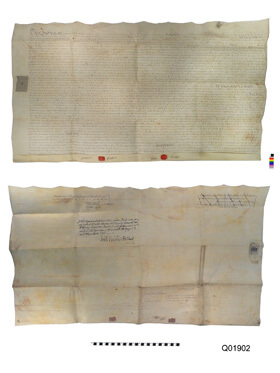Imagine walking into a real estate agent’s office and asking to buy an oxgang of land. You would most likely receive some very strange looks and be sent packing. Or you might just be lucky enough to talk to a real estate agent who knew something about historical land measurements. They would then realise that you were using a unit of measurement that has been in vogue in England and Scotland since the early 16th century and under another name, a bovate, right back to the Vikings.

Medieval Measures
The Domesday Book refers to a bovata, which represents the amount of land which could be ploughed using one ox in a single annual season. The Latin word for ox is Bos (from which we also get our descriptive word, bovine, meaning slightly slow and stupid). Thus depending on the abilities of a ploughman, an oxgang could range between 15 and 20 acres. A furlong (meaning furrow length) was the distance an ox- team could plough without resting. Pulling a plough through the heavy northern soils of the British Isles would strain any bovine ox! A rod, another form of measurement, was equal to about 5 metres and may have originated from the length of an ox goad, used to drive the animals forward.
Manuscript reveals old land measurements
So, why do i have a sudden interest in ancient land measurements, you may ask. In the Abbey Museum collection we have a document, an indenture or Sale of land, dated 1769, that I have been slowly translating from the scribal handwriting. It is reasonably erudite, except when words like a Messuage House or Tenement, Garth or Croft and then Oxgang are used. A Messuage House is a dwelling house with outbuildings in a garth or croft (an enclosed yard). In Scotland crofters was the name given to poorer people who lived in a crofthouse. I find it fascinating how reading an old document, even something as basic and prosaic as a deed of land title can bring voices from the past echoing down the corridors of time.

18th Century Land Sale Document
Baker Brothers Buy an Oxgang of Land
In our document, Samuel Baker and his brother John are exchanging a parcel of land amounting to an oxgang with a William Lyth. They come from Wilton, a delightful little North Yorkshire village, whose main claim to fame seems to be that each day traffic on the AI road has to stop by law to allow the farmer to take his cows to pasture on the other side. Our document is extremely wordy with constant and amazing repetition as if the scribe was being paid by the word (which in many cases they were). Lawyers were not a favourite group of people, often taking half a year of income just to create a legal document. But interestingly, it still uses the feast of St Martin the Bishop as a marker for when payments would begin. Up in the Yorkshire dales, tradition dies hard and even land rights and the great enclosures of the 17th and 18th centuries reach back to a catholic time when saints ruled the year with feast days and holy days being measurements of time and days.

